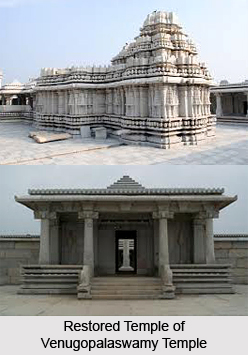 History of Venugopala Swamy temple is closely associated with the place named Devanahalli. Devanahalli is a small town on the outskirts of Bengaluru. The town of Devanahalli shot into fame the day it was chosen for the construction of International Airport. Devanahalli is also a potential heritage hotspot for the tourists of all over India.
History of Venugopala Swamy temple is closely associated with the place named Devanahalli. Devanahalli is a small town on the outskirts of Bengaluru. The town of Devanahalli shot into fame the day it was chosen for the construction of International Airport. Devanahalli is also a potential heritage hotspot for the tourists of all over India.
Venugopala Swamy temple was built in the medieval time that is the 12th Century. This temple is the elegant example of Hoysala art and architecture. Near the temple of Venugopala Swamy and its complex, there exists the beautiful fort. This fort is the tourist attraction spot in this region. There are many temples in the fort dedicated to the South Indian Gods like Venugopalaswamy, Nanjundeshwara, Chandramauleshwara, Veerabhadraswamy and Ranganathaswamy. The temples near Venugopala Swamy temple are belonging to various eras like the early phase of medieval era and the modern era.
Venugopala Swamy temple is the oldest temple in this region. It has a tall Rajagopura at the entrance and has a spacious inner Prakara with Garuda Stambha or the pillars of Garuda. At the entrance, there placed the two statutes of Lord Vishnu of Western Ganga Dynasty. Devanahalli, the place where Venugopala Swamy temple is located, is also famous because Hyder Ali resided here. According to some local folk stories this place is the birthplace of Tipu Sultan, The Tiger of Mysore, who was the son of Hyder Ali.
Ranabera Gowda, the resident of Kanchi had came and settled in a village named Avathi near Benthakalur, which is now known as the famous metropolitan city, Bengaluru. One day a hailstorm and rain came and it washed away their settlement. Then they collected all the belongings whatever they could lay hand on, and kept them under a tree, then one broom stick got struck in an ant hill and when they tried to pull it did not come, so they left it and slept under a tree. In night they got a dream. In that dream, they found the existence of seven vessels of gold and jewellery. Then idol of Venugopala Swamy and Thimarayana Swamy came in their dreams. From that time these two idols are placed there, where the temple was later built.
For more than 70 years the temple lay underwater due to the construction of the dam project named Krishna Raja Sagara Dam Project during the rule of British Government in India. Later in modern days the temple of Venugopala Swamy was restored and now it became one of the major attraction sites in Devanahalli of Karnataka.
In December 2011, the temple complex of Venugopala Swamy Temple was restored. Now this place is the tourist hotspot.





















